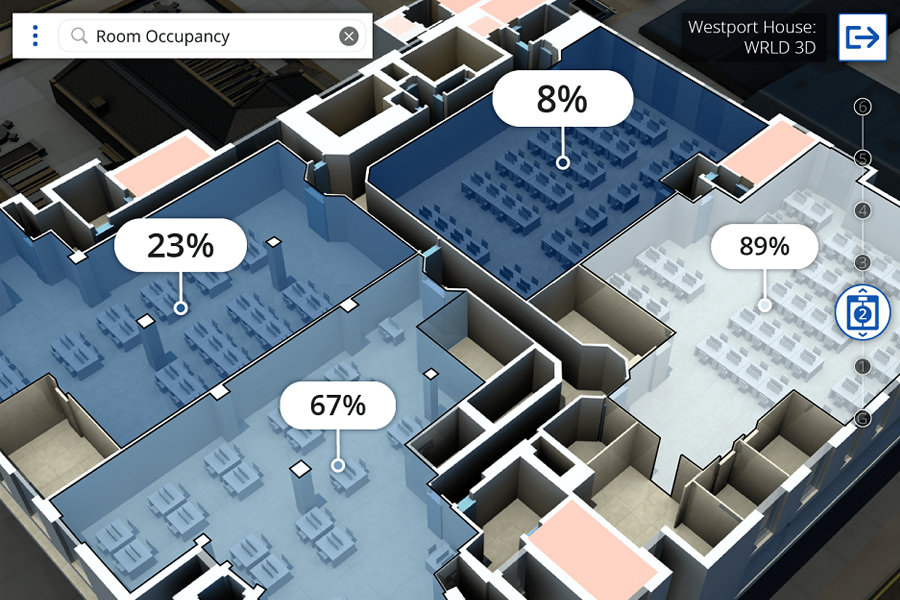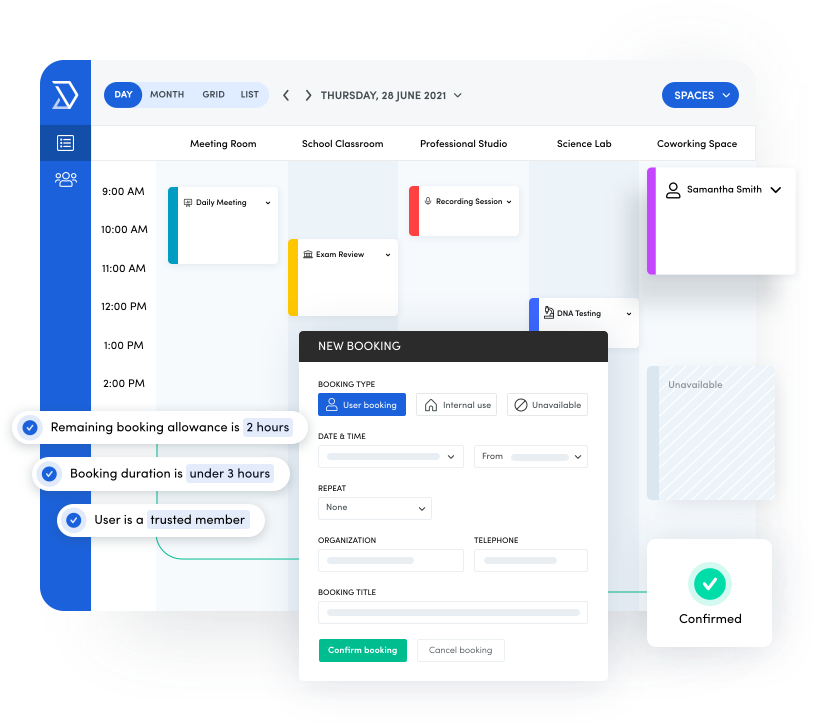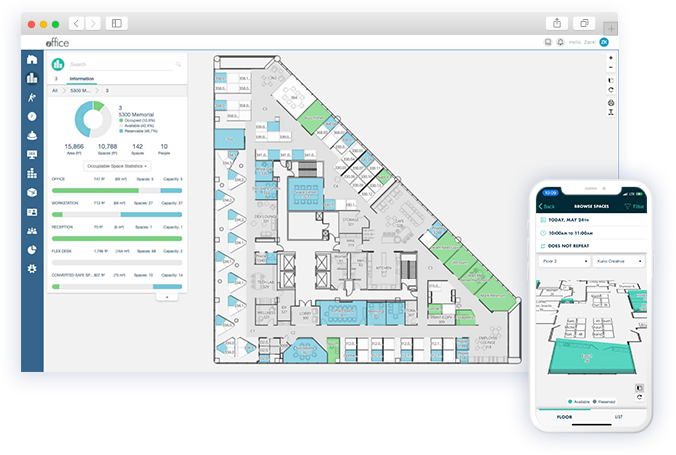How to Create a Space Management App for Offices: Types, Best Examples, and Features
Office space management is quite tricky, especially if you have multiple teams or even organizations working in the same building. Learn how you can create your own office space management solution, either for your own company or as a SaaS product for other businesses to use
The office game has changed after the COVID-19 pandemic. For more than a year, many offices became empty. Many companies offer a hybrid approach, and people are partly returning to work in an office. More and more companies are using software to manage office space.
With the COVID-19 pandemic, the demand for flexible, cost-efficient and hybrid office management has increased
However, apps for office management now require more flexibility, as people come into the office to work on random days, and the number of people in the office fluctuates daily.
This is where space management apps can be a powerful tool for office managers. In this article, we’ll discuss space management apps for offices and how you can develop such software for your business through mobile app development services.
What are space management apps for offices?
Space management applications are pieces of software that help businesses to manage their office space and equipment and also schedule the use of certain premises like conference rooms, meeting spaces, and even individual desks. They are similar to project management software with integrated calendars, schedules, and timeline alerts.
On a larger scale, office space scheduling software can help real estate owners to manage multiple premises that are shared among multiple businesses that rent out office space.
Space management apps allow users to see what spaces in an office are currently free, what time slots are available for their use, etc. Many space management apps also provide communication and collaboration tools as a part of their functionality.
For example, the users can set up meetings, plan projects, and have after-work happy hours in a common space.

Other possibilities include help in space planning, social distancing, predictive analysis based on historical data, creating virtual floorplans, and viewing wasted space.
Large companies with multiple office facilities sometimes build their own office management solutions. In contrast, smaller companies use SaaS products they can use by paying every month instead of investing in their office space utilization software.
There are currently multiple SaaS solutions on the market you can take inspiration from, like WorkinSync, POC System, Accordant, OfficeSpace, Wisp, and more. Let’s learn about the types of office management apps and their features.
Types of office management apps and their features
All office space management apps can be divided into several loose categories that are often intertwined within a single solution. Let’s take a look at the main types of office management apps and highlight their main features.
Conference room booking apps
These apps allow office workers to see what rooms are available and book them for upcoming meetings. They look similar to Google Calendar, where users can view room schedules inside a building.

Meeting room booking apps help to facilitate the booking process of everything in an office space, from conference rooms to even separate desks in a coworking space.
The main features of such apps are:
- Calendar with shared access
- Room or desk booking
- Booking cancellation
- Sending invitations
- Integration with Slack, Zoom, and other messaging and conferencing apps
- Floor plans and room layouts
- Notifications and reminders on the upcoming meetings
Equipment and asset management apps
These applications help office managers to keep track of all the assets they have in an office, from office supplies and furniture to equipment like computers, servers, etc.
Equipment management applications also help with moving to other offices, doing asset audits, and more.
The features of this type of application include:
- Equipment listing
- GPS tracking for moveable equipment
- Facility layout design
- Ability to add a description to each tracked item and edit it
- Notifications on updates in equipment status
Corporate real estate management apps
This kind of space management app helps corporate real estate owners to have a helicopter view over each of their properties, analyze their profitability, predict earnings, optimize the spaces available for rent, identify a budget that goes to waste, assess the operational expenses, and more.

The features of corporate space management apps include:
- Strong analytics
- Ability to add, delete and edit assets
- Detailed floor plans and facility layouts
- Reporting on earnings, operational costs, and cost per employee
- Real-time reports on facility occupancy
- Office space optimization
- Risk assessment
- Predictive maintenance
- Notifications and alerts on upcoming key dates
- Leese agreement and document storage
Smart office apps
Smart office applications are IoT apps that control the environment in the offices and make sure it’s comfortable for workers.
They help to control smart devices like thermostats, humidifiers, intelligent lightbulbs, locks, GPS trackers, air quality monitors, etc.
- Integration with IoT platform
- Dashboard with all active devices
- Manual device control
- Ability to set up automated scenarios for IoT devices
- Reports and graphs on the current state of the facility and each device
- Ability to add and delete devices
- Alerts on needed maintenance
- NFC for smart locks
Apart from this classification, office management apps can also be divided into categories by domain. There are apps for businesses in:
- IT and software development
- Finance
- Business services
- Manufacturing
- BioTech & Pharma
- Corporate real estate
Large office space management platforms often merge multiple types of apps and offer features that allow businesses to:
- Empower their employees by giving them convenient tools for room and desk booking and scheduling
- Facilitate the events like office reopenings, moving, etc
- Track and manage their assets
- Establish a great culture of hybrid and flexible work
- Encourage in-person collaboration and meetings
- Manage multiple facilities across buildings, cities, and even countries
Now let’s go through the whole process of building your office space management application, from A to Z.
How to create a space management app for offices
Step 1. Define your concept
You already know that there are many issues an office space management app can solve, and there are many domains you can target with your solution.
Your first step is to choose your niche and a type of office space management solution you need to cater to your target audience.
Think about your competitors who already operate in your target market. Analyze them, pick the functionality or services you’d like to provide, and also consider what you could do better in order to stand out.
Step 2. Find your vendor
The most cost-effective way to build a space management solution is to hire a software development company. Surely, you can hire a full in-house team, but this may be costly due to local salaries, taxes, equipment, HR costs, and other expenses.
Where do you find a reliable vendor? Here are some ways to find your perfect team:
- Ask for recommendations from your business partners, acquaintances, and colleagues if they’ve already had experience with outsourcing development
- Google the topics you’re interested in (this is probably exactly how you found this article!)
- Check websites like Clutch.co for reviews from previous clients
- Check your candidates’ portfolios: bonus points if they’ve built a mobile app with similar functionality!
Step 3. Go through a discovery phase
It’s impossible to build a successful software product without planning, and a discovery phase is exactly for that. During this phase, a business analyst extracts your requirements into a technical specification.
A technical specification is a document that describes the future product, its functionality, third-party integrations, architecture, requirements, and more. It also contains wireframes that describe the core UX of your future product.
To build a technical specification, a business analyst also performs market research, competitor analysis, SWOT analysis, and more.
With the ready documentation, you can be sure you’ll get exactly what your business needs and everyone on the team will have a clear understanding of the goals and processes of the project.
Step 4. Build and test your app
Now it’s time to build your application. To accelerate your time-to-market, you can prioritize features and create an MVP first. This way, you’ll be able to release your space management app sooner and continue the development based on user feedback and real market response.
According to the best practices of Agile development, building and testing processes happen simultaneously, which optimizes the processes and allows developers to deliver a very high-quality product.
In this process, you’ll get daily, and weekly reports and updates on the development process and adjust them according to your current business needs and market conditions.
Step 5. Release and maintain your application
The work on your office management solution doesn’t stop at the release. Now it’s vital to maintain and update your software for managing office space regularly to stay relevant. If you offer a SaaS solution to other businesses, you’ll also need to add new features and improve the existing ones regularly.
The maintenance activities include:
- Bug fixing
- OS updates
- Third-party service updates
- Library updates
- Code refactoring
- Security checks
The post-release activities can also include:
- New feature development
- Redesign
- Architecture improvements for scalability
Final thoughts
Office work changed, and now businesses need to adapt to new rules. Office workers demand convenience, flexibility, hybrid approach, and at the same time businesses strive to cost optimization.
Office space management software is what can help businesses, office managers, and corporate real estate owners to optimize their work, facilitate communication, and cut costs.
In this article, you’ve learned about building an office space management app for your business or as a B2B SaaS solution. If you have any more questions about creating this type of software, don’t hesitate to contact us.

